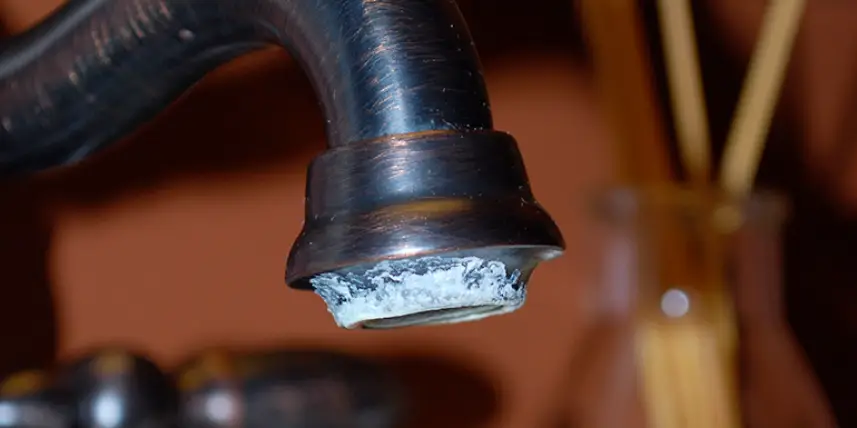
When you first moved into your place, everything was clean and beautiful. But now there’s white residue coating your faucets. What is that? And what caused it?
The whitish residue is called calcium buildup or limescale. It originates from leftover mineral deposits from hard water.
There’s good news, though; you can remove calcium buildup on faucets using a few household items. We’ll explain which items you need to remove calcium buildup, outline the cleaning process, and discuss prevention:
- Items Needed for Calcium Buildup Removal
- How to Clean Calcium Buildup
- Calcium Buildup Prevention
Items Needed for Calcium Buildup Removal
Removing calcium deposits takes a little elbow grease, but at least the items are easy to obtain. To tackle the limescale on your faucet, first gather the following household items:
- White vinegar
- Paper towels or strips of soft rags
- Rubber bands
- Plastic sandwich bags
- Sponge or textured cloth
- Magic eraser (optional)
- Commercial cleaner for calcium, lime, and rust* (optional)
*White vinegar is usually enough to remove the calcium buildup, but if you plan to use commercial cleaners with these instructions, wear rubber gloves and avoid inhaling the fumes as you clean.
How to Clean Calcium Buildup
Once you have your supplies, start by cleaning the exterior of the faucet. To do this, soak several paper towels or rags in white vinegar. Wrap them around the affected areas of the faucet and secure them in place with rubber bands. Leave the wrappings in place for at least one hour.
After an hour, remove the wrapping and wipe the faucet clean with a damp cloth. Use a magic eraser if the cloth doesn’t remove much of the calcium buildup. Once you have wiped off the calcium buildup, let the faucet dry completely.
Calcium buildup is most obvious when it’s on the outside of a faucet, but it also forms in the mouths of faucets and showerheads. To clean these areas, fill a small sandwich bag with distilled white vinegar. Secure the bag to the mouth of the faucet using a rubber band. Make sure the mouth of the faucet is fully submerged in the vinegar.
Leave the bag in place for at least one hour. Afterward, remove the bag and wipe the mouth of the faucet with a damp cloth. You can use a magic eraser for stubborn limescale.
If the buildup won’t chip away even after trying this, or you notice you have water flow issues, it’s time to call a plumber. Mr. Rooter Plumbing can remove calcium buildup on faucets quickly and effectively, preventing clogs and permanent damage to your faucet.
How Do I Prevent Calcium Buildup on My Faucets?
The best way to prevent calcium buildup and maximize the life of your plumbing system is to have a water softener installed. If you already have one, keep it well maintained so it performs effectively, or have it repaired if needed.
The inside of your pipes is vulnerable to calcium buildup, too. Installing a water softener is the only way to reliably prevent this kind of buildup. Limescale on your faucet is a minor annoyance, but limescale inside your pipes is a major problem.
If you don’t want to install a water softener, you can reduce limescale issues by frequently cleaning your faucet. Follow the same process you would for removing calcium buildup on a faucet, but on a biweekly basis. This can help prevent buildup on your faucets.
Remove Stubborn Calcium Buildup with Help from Mr. Rooter Plumbing
If cleaning your faucets does not improve your water pressure, your pipes may be caked with limescale, or there could be another issue. Ask your local Mr. Rooter Plumbing for a plumbing inspection and consultation. Whether you need pipe replacements or a simpler repair, our plumbing pros will always provide upfront pricing and exceptional customer service. Schedule an appointment online or call us for emergency service.

